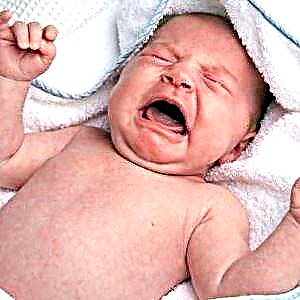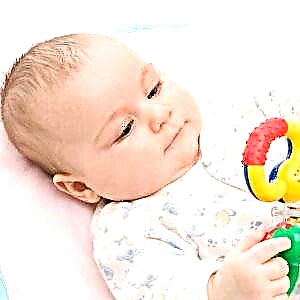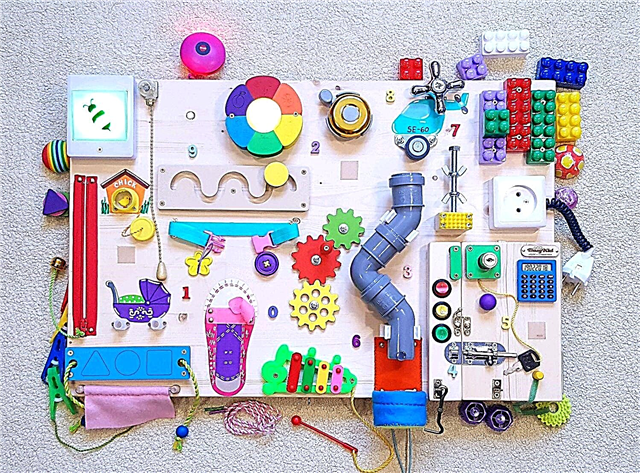Dysbacteriosis in infants is a very common phenomenon. Many parents are concerned about the normal functioning of the baby's intestines and stomach. However, many do not know the main signs of the manifestations of the disease. And they often panic in vain.
Dysbacteriosis is any disorder of the healthy balance of the intestinal microflora that interferes with the natural balance between pathogenic and beneficial microorganisms, which causes a disturbance in the normal functioning of the intestines.
Dysbacteriosis in infants
Human intestinal microorganisms divided into two subspecies:
Mandatory flora
Microorganisms in this category are simply vital for the smooth functioning of the digestive system. They are essential for the digestion process and the optimal functioning of the immune system.
 This group of microorganisms includes lactobacilli, bifidobacteria, E. coli. Saprophytic microflora, which does not affect human health, positive or negative, also belongs to the obligatory flora. This group is the widest and forms approximately 96% of the intestinal microflora.
This group of microorganisms includes lactobacilli, bifidobacteria, E. coli. Saprophytic microflora, which does not affect human health, positive or negative, also belongs to the obligatory flora. This group is the widest and forms approximately 96% of the intestinal microflora.
Optional microflora
Microorganisms of this class are present in the intestines in small quantities, and in unfavorable conditions, such as decreased immunity, stress, trauma, unhealthy diet, they begin to multiply dynamically.
But after reaching a critical point, this pathogenic microflora often leads to many intestinal infections. Conditionally pathogenic microflora includes such microorganisms as staphylococci, proteus, fungi of the genus Candida.
In adults, the presence of such microflora does not always cause disease. In infants, however, whose immune systems are not yet fully functional, always.
The role of healthy microflora
The presence of beneficial bacteria (lactobacilli, bifidobacteria) in the child's body, as mentioned above, is mandatory.

1. With a sufficient number of these microorganisms in the intestine, all pathogens are displaced. This is due to the fact that the waste of these bacteria creates an environment in which the life of pathogenic organisms is simply impossible.
2. Another, no less significant role of beneficial microorganisms is to maintain the normal functioning of the immune system. The presence of bifidobacteria and lactobacilli stimulates the production of antibodies that protect the infant from various pathogens entering the body. It is not in vain that when a child's microflora fails, a significant weakening of the immune system occurs so often.
3. Lactobacilli and bifidobacteria are responsible for the production of vitamins such as:
- vitamin B6;
- folic acid;
- cyanocobalamin.
These vitamins are essential for a child's growth and the functioning of their immune system. Also, these microorganisms are responsible for the complete absorption of vitamin D, calcium, iron.
4. In addition, another important function of microflora is to stimulate intestinal motility. Normal peristalsis is necessary to avoid constipation in a child.
Understanding all this, it becomes clear the importance of the correct balance of bacteria in the gut of the infant. If the ratio is violated, the risk of developing rickets, hypovitaminosis, and iron deficiency anemia increases. The risk of intestinal infections is also significantly increased.
How is microflora formed?
A baby is born with a completely sterile intestine.
 the starting point of her acquisition by a baby is childbirth;
the starting point of her acquisition by a baby is childbirth;- as soon as it appears, the baby contacts the outside world, and her body at this time continues to be colonized by microorganisms;
- after elementary processing, the baby is laid out on the mother's belly. The child receives another portion of the microflora, which is given by the mother's skin, thereby preventing the initial colonization of foreign microflora;
- further, perhaps the most important moment in a child's life is the first breastfeeding. After the mother's nipple is placed in the newborn's mouth, the baby takes the first sip of valuable colostrum. At this stage, the first stone is laid in the foundation of health. In addition to the fact that colostrum contains a huge amount of various nutrients that a child needs, it includes factors that influence the formation of the natural intestinal microflora.
The benefits of colostrum
Colostrum is saturated with bifidogenic elements that stimulate the growth and development of bifidobacteria. Once in the child's body, this substance creates a suitable environment for the life of bifidobacteria and lactobacilli. In addition, a large number of colostrum immunoglobulins are a kind of biological shield against a large number of diseases.
That is why babies attached to the breast in the first 2 hours of life are healthier and stronger than their peers, who were separated from the mother's breast from birth. In the former, the growth of normal bacterial flora was found, cases of dysbiosis are much less common, they develop harmoniously and gain body weight.
- within the next 3 to 5 days after the first feeding, the baby is exposed to a variety of intestinal microorganisms. And among the organisms entering the intestines, there are quite a few opportunistic and pathogenic microflora. Therefore, in the first week of life, the following symptoms are often observed - watery stools with mucus and streaks of green color, abdominal pain, regurgitation;
- at the end of the first week, the child begins the next phase of intestinal colonization with microorganisms. By this time, bifidobacteria and lactobacilli, which were obtained immediately after birth, multiply rapidly and begin to expel pathogenic microorganisms.
The overgrowth of transit bacteria is not in itself a disease. Unless it is combined with deep prematurity, taking antibiotics and the presence of infectious diseases.
Primary requirements
To pass this stage safely, a number of specific requirements must be met:
 early breastfeeding, preferably in the first 2 hours after the birth of the baby;
early breastfeeding, preferably in the first 2 hours after the birth of the baby;- breastfeeding on demand all the time. The point is that breastfeeding a child with dysbiosis should not even be discussed. If there is breast milk, it is only the breast;
- finding the child and mother together.
If these simple rules are violated, the chances of developing an initial intestinal dysbiosis will increase dramatically. As a result, there will be a violation of the normal functioning of the digestive system and the process of defecation. Symptoms of dysbiosis in a child will appear quickly enough.
What can influence the colonization of beneficial flora, maintenance of a balanced and healthy gastrointestinal microclimate in an infant's body?
This is a combination of factors, including the maternal microflora, the maternal diet, the route of delivery, the way of feeding, the use of antibiotics. Violation of the intestinal microflora leads to the multiplication of pathogenic microorganisms and impaired development of the immune system.
Intestinal dysbiosis can occur in a child due to the birth by cesarean section, taking antibiotics during breastfeeding and associated dysbiotic changes in the mother's body, late attachment to the breast or lack of natural feeding, hypoxic-ischemic pathology of the central nervous system of the child (cerebral ischemia 2 degree).
Sometimes parents do not even know that the child has dysbiosis. This happens not because of neglect of the health of the baby, but because of ignorance of how dysbiosis manifests itself in infants. In addition, many babies suffer from colic for the first three months. Their intestines simply didn't adapt to the new situation. The weather also has an impact. Mostly negative.
Signs of dysbiosis
The main signs of dysbiosis in newborns include:
 bloating. When you feel it, it is noticeable that the tummy is very tight, like an inflated ball;
bloating. When you feel it, it is noticeable that the tummy is very tight, like an inflated ball;- flatulence. If you hold your hand on the baby's belly, you can feel a constant rumbling, gurgling, accompanied by the release of gases. Moreover, just before this moment, the baby may freeze and cry;
- abdominal pain. An older child can show where it hurts, but the baby is not able to do it. Hence, the main symptom is abdominal pain. But there is one more sign by which you can find out what exactly is bothering your stomach. When crying with a spasm, the child will curl his legs. And until the pain subsides, he will be in this position;
- bad breath. Everyone is used to the fact that small children should smell good. But with the development of dysbiosis, bad breath appears;
- salivation. If in children older than 4 months, profuse salivation is considered normal, since the salivary glands begin to work hard and teeth erupt, for younger age groups, increased salivation may indicate a disease;
- dermatitis. Parents whose children suffer from dysbiosis very often observe a rash on children's skin. This can happen from the introduction of new food, or for no apparent reason;
- constipation. You must be careful if a child has no stool for more than two days, as this leads to intoxication, which is extremely dangerous. This happens due to the fact that the content of bifidobacteria in the baby's intestines is significantly reduced. They control peristalsis, which is absolutely necessary for normal baby stool;
- diarrhea, does not stop for several days, even after treatment. There is a violation of the absorption of nutrients in the small intestine;
- poor weight gain. Indicators may be below normal by a pound or not at all;
- the presence of mucus in the stool. It will take up almost all the contents of the feces, and such a stool smells rather peculiar and unpleasant.
Types of dysbiosis
Depending on the cause of dysbiosis, doctors distinguish the following types of disease:
Compensated dysbiosis
With this form, the child has no external signs of the disease. Parents believe that the baby is doing well.
It proceeds without disturbance of digestion or without changes in the stool. And the dysbacteriosis itself in an infant is found, as a rule, completely by accident, when analyzing feces.
And, as a rule, the reason for this research is any other disease or simple examination. An analysis for dysbiosis in infants is rarely the goal.

Uncompensated dysbiosis
The uncompensated type of dysbiosis brings many health problems. All of the above signs of this disease require treatment. Treatment of dysbiosis in infants should be started immediately, avoiding further deterioration.
In the end, neglect of the manifestations of dysbiosis will lead to a worsening of the infant's condition and more difficult and prolonged treatment.
With a compensated form of dysbiosis, good weight gain and no complaints, parents often refuse treatment in children under one year old, believing that there is no cause for concern.
Such inattention to dysbiosis can be shown if the baby is older than a year. But dysbiosis in a one-month-old baby requires a serious attitude, regardless of whether it is compensated or not.
In young children, the concept of compensation is very unstable. In the morning everything is good enough, and by the evening, uncompensated dysbiosis will develop, which proceeds in a very severe form. This is why the right treatment is needed.
The degree of dysbiosis in children
There are four of them. And each has its own characteristic features:
 first degree. It usually develops when a child is malnourished and has an allergic reaction to certain foods, especially with the introduction of complementary foods. When it comes to symptoms, few people behave like they always do. Loss of appetite, flatulence and discoloration of stools are present. There is a lack of regularity in the increase in body weight;
first degree. It usually develops when a child is malnourished and has an allergic reaction to certain foods, especially with the introduction of complementary foods. When it comes to symptoms, few people behave like they always do. Loss of appetite, flatulence and discoloration of stools are present. There is a lack of regularity in the increase in body weight;- second degree. It is characterized by the presence of bacteria in the intestines, which negatively affect the flora. Symptoms are much more pronounced and include problems with stools (constipation or diarrhea), severe flatulence, abdominal pain, foul smelling feces and the presence of mucus and undigested parts of food in them. It should be noted that for infants who are fed only breast milk or formula, normal, mushy, yellow stools. The smell will resemble either yogurt or sour cream;
- third degree. If, when the first signals are detected, dysbiosis is not properly treated, it can easily progress to a more serious stage, which will be characterized by slightly different symptoms. The child becomes lethargic, weak, often there are abdominal pains, diarrhea, nausea are observed. The stools turn green, with a lot of mucus, and a persistent and unpleasant odor similar to that of rotten eggs. There is also a large amount of undigested food. As a rule, against the background of the above symptoms, the child begins to eat poorly and stops gaining weight;
- fourth degree. This is the most dangerous form of the disease, which is characterized by general poisoning, vomiting, and nausea. It is observed due to the spread of harmful microbes throughout the body. The body temperature rises, and abdominal pains begin. At first, it can be assumed that this is an intestinal infection. Children stop eating, do not gain weight, and a decrease in hemoglobin levels is observed in blood tests.
Any of the listed symptoms should alarm parents, since only with their attention and care can one suspect a disease at its initial stage and begin treatment on time, in order to avoid complications for the child's body.
If within a few days the child has a fever, an unpleasant odor, and the urine becomes dark, it is better to call an ambulance, as this may require additional help in the form of a dropper with drugs to stabilize the baby's condition.
Some parents are in no hurry to see a doctor because they believe they can cope on their own. But dysbiosis, especially in infants, is a dangerous disease.
If a month-old child has symptoms such as diarrhea more than 10 times a day, vomiting, fever, there is no weight gain, a doctor's examination is urgently needed, since these are the first and most dangerous symptoms of dysbiosis.
For newborns, weight loss of more than 10 percent can be complicated by multiple organ failure, and if dehydration, which is caused by diarrhea and vomiting, is added, the risk of death increases.
In no case do not delay the trip to the doctor when the first signs of dysbiosis appear, since microbes can multiply and spread throughout the body so quickly that the first degree can easily go straight to the fourth.
If you suspect a disease and have identified characteristic signs of dysbiosis in children (changes in stool, abdominal pain, rash, and so on), consult a doctor immediately.
How to identify dysbiosis?
To make an accurate diagnosis, the doctor must run a series of tests to verify his assumptions.

Several steps are required to make a diagnosis:
- It is necessary to do a bacteriological study of feces. This test can detect the presence of pathogenic microorganisms and identify the pathogen. When studying microflora using this analysis, you can determine the ratio of bacteria at the moment. Probably, there will be an increase in the conditionally pathogenic flora - streptococci and staphylococci, Klebsiels and fungi. The analysis is not always able to reflect the objective state of the intestine. Microflora is individual and variable, subject to various conditions. In addition, the analysis, as a rule, ignores the microflora of the small intestine, changes in which have an impact on the state of the digestive system.
- Stool culture must be done. As a rule, the analysis is carried out within a week, since during this time bacteria multiply and grow, and doctors examine them and find antibiotic resistance.
- It is important to make a coprogram that shows the presence of undigested food pieces in the feces and detects signs of inflammation in the metabolic products of the intestinal microflora.
- The doctor can prescribe additional tests and examinations - general and clinical blood tests, urinalysis, helminth eggs, gastroenterologist consultation and gastroscopy.
After receiving the test results, the specialist will be able to make an accurate diagnosis. The choice of treatment will be agreed with the parents.
Treatment of dysbiosis in children
After the parents' fears were confirmed, a logical question arises: how to treat dysbiosis in children?
Before the treatment of dysbiosis, it is required to conduct a study of the child's feces, for an accurate diagnosis of the disease and the detection of intestinal infections. After the tests, a laboratory report will be received confirming the presence of dysbiosis in the baby. Now you can go directly to the treatment.
Dysbiosis treatment occurs in two stages:
- Achievement of complete cessation of reproduction and growth of anomalous flora. To do this, doctors prescribe special drugs called bacteriophages. These immunopreparations absorb and remove all pathogens from the body. In case of complications, when the bacteriophages cannot cope, doctors are forced to prescribe an intestinal antiseptic and, possibly, an antibiotic. Those antibiotics are used that affect only the intestines, are not absorbed into the blood.
- Prescribing a treatment that improves the intestinal microflora and creates the necessary favorable conditions for its growth and development. For this purpose, probiotics are suitable - preparations containing live bifidobacteria, lactobacilli and Escherichia coli. You cannot recommend a specific medication, treatment is carried out only by a doctor and in each case should be individual.
When parents know how to treat dysbiosis in infants, many complications of this disease can be avoided.
Prevention of dysbiosis
Of course, it is much wiser to try to prevent the development of dysbiosis than to cure it. This should be done as early as possible, before pregnancy. Before pregnancy, a woman must be fully examined in order to detect and eliminate violations of the microflora of the genitourinary system.
 In the same case, if a fungal infection is detected during pregnancy, you should immediately begin treatment. Pharmacology currently has a large number of drugs that can be used during pregnancy.
In the same case, if a fungal infection is detected during pregnancy, you should immediately begin treatment. Pharmacology currently has a large number of drugs that can be used during pregnancy.
The best prevention of dysbiosis is correct and long-term breastfeeding of the baby. Every child needs mother's immunity for at least the first year of life.
It was said that colostrum is a huge amount of substances that contribute to the formation of normal microflora. But mature breast milk has no less beneficial effect on the infant's intestinal flora. It creates a healthy environment for the growth and development of beneficial bacteria, helps maintain the necessary balance between lactobacilli, Escherichia coli and bifidobacteria, thereby ensuring not only healthy digestion, but also the prevention of allergic reactions.
If breastfeeding is impossible, then it is necessary to take a responsible approach to the task of choosing a milk formula. It contains additional protective components. Such mixtures must contain prebiotics. Prebiotics are substances that create a fertile environment for beneficial bacteria.
It must be borne in mind that when choosing a therapeutic mixture, consult your pediatrician.
Dysbacteriosis in newborns is a very common phenomenon today. And the problem is not that the parents are careless about the child, but that the ecological situation is so difficult that it can harm the baby and lead to disturbances in such a fragile little body.

 the starting point of her acquisition by a baby is childbirth;
the starting point of her acquisition by a baby is childbirth; early breastfeeding, preferably in the first 2 hours after the birth of the baby;
early breastfeeding, preferably in the first 2 hours after the birth of the baby; bloating. When you feel it, it is noticeable that the tummy is very tight, like an inflated ball;
bloating. When you feel it, it is noticeable that the tummy is very tight, like an inflated ball; first degree. It usually develops when a child is malnourished and has an allergic reaction to certain foods, especially with the introduction of complementary foods. When it comes to symptoms, few people behave like they always do. Loss of appetite, flatulence and discoloration of stools are present. There is a lack of regularity in the increase in body weight;
first degree. It usually develops when a child is malnourished and has an allergic reaction to certain foods, especially with the introduction of complementary foods. When it comes to symptoms, few people behave like they always do. Loss of appetite, flatulence and discoloration of stools are present. There is a lack of regularity in the increase in body weight;

